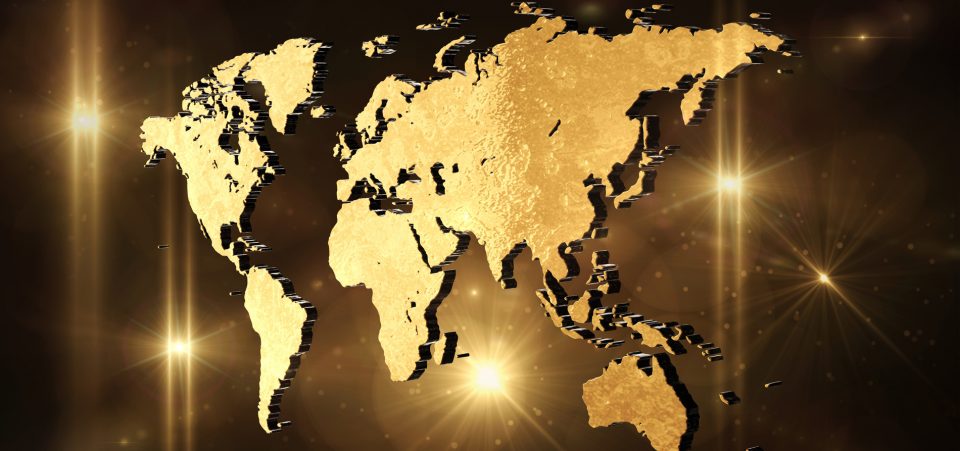Which Country Has the Most Gold?
Central banks have printed trillions of dollars in paper money, and inflation is starting to pick up. No wonder we’ve seen a spike in the number of Internet searches for phrases like “countries with highest gold reserves” and “which countries have the most gold.” People are preparing for the worst, and they’re wondering where the best places might be to park their money.
In terms of price, gold hasn’t done much of anything since finding an intermediate bottom in the low $1,200s in 2012. This intermediate bottom represented a 45% drop from gold’s all-time high just 22 months earlier. It was a clear signal that gold’s heyday was over, at least temporarily.
The substantial fall from peak prices was also overdue. The move from $360.00 to $1945.00 from 2001 to 2011 represented a 540% increase in prices over an 11-year span. While numerous issues such as the dotcom bubble and U.S. housing crisis boosted gold demand as a hedge against crisis, debt, and monetary debasement, gold’s advance was undoubtedly running hot. A predictable price decline and consolidation was due, and that’s exactly where we are today.
That doesn’t mean the reasons to own gold have ceased, however. Judging by the actions of central banks worldwide, we tend to agree.
Central banks first began slashing their net gold holding in 2008, owing largely to the U.S. housing crisis. At the time, the risk of solvency in the banking sector was very real. Banks had built up towers of debt through collateralized debt obligations (CDO), which offered attractive interest rates for seemingly iron-clad debt. Once overheated housing prices started to crash, however, CDO debt became worthless and left many big banks holding the bag.
Net gold purchases turned positive after two decades of sales largely due to massive dollar debasement—quantitative easing (QE)—in the aftermath of the U.S. housing crisis. In response to deep recessionary forces bludgeoning the economy, Barack Obama signed into law the American Recovery and Reinvestment Act of 2009.
The approximate cost of the economic stimulus package was estimated to be $787.0 billion at the time of passage, later revised to $831.0 billion between 2009 and 2019. (Source: “Estimated Impact of the American Recovery and Reinvestment Act on Employment and Economic Output from October 2011 Through December 2011,” Congressional Budget Office, last accessed February 14, 2017.)
This mechanics of QE extended beyond America’s borders, with similar and prolonged programs initiated by the European Central Bank (ECB) and the Bank of England.
While all this monetary stimulus boosted U.S. and pan-European stock indexes to all-time highs, there are concerns global growth is flagging under the immense weight of debt.
Indeed, China has just announced gross domestic product (GDP) growth at 6.8%, its slowest pace in 26 years. This is despite credit expanding double the rate of GDP and a devaluating yuan. This will likely result in increased federal and corporate debt issuance, as the Chinese government refuses to allow the business cycle to self-correct.
When China is eventually forced to come to terms with its massive private debt liabilities, domestic growth will crater and likely lead to a renewed global recession. Think of central bank buying as a future hedge against this very possibility.
While no one knows exactly when the game of musical chairs will end, it stands to reason that countries with high gold reserves stand to benefit.
Which Central Banks Are Buying?
In 2016, world central banks showed a little more restraint. On a net basis through the third quarter, net purchases totaled 271.1 tonnes, down from 407.7 tonnes from the same period in 2015. Still, the increasing purchases of gold now accounts for 13% of all central bank reserves, and rising.
Although central banks may be adopting a wait-and-see approach, expect rising gold reserves by country trends to re-emerge should the United States falter economically under Donald Trump, Chinese debt spirals out of control, or a host of other reasons.
So which country has the most gold? There is only one, and it’s the country you think. But here are the other nine countries, which may not be so obvious. (Source: “Latest World Official Gold Reserves,” World Gold Council, last updated February 2, 2017.)
Gold Reserves by Country (as of February 2017)
| Rank | Country/Organization | Gold Holdings (in tonnes) |
Gold’s Share of Forex Reserves |
|---|---|---|---|
| 1 |  United States United States |
8,133.5 | 73.8% |
| 2 |  Germany Germany |
3,377.9 | 67.6% |
| 3 | International Monetary Fund | 2,814.0 | N/A |
| 4 |  Italy Italy |
2,451.8 | 66.8% |
| 5 |  France France |
2,435.8 | 61.5% |
| 6 |  China China |
1,842.6 | 2.2% |
| 7 |  Russia Russia |
1,615.2 | 15.2% |
| 8 |  Switzerland Switzerland |
1,040.0 | 5.6% |
| 9 |  Japan Japan |
765.2 | 2.3% |
| 10 |  Netherlands Netherlands |
612.5 | 62.8% |
10. Netherlands
The Netherlands is rarely in the media regarding gold-related matters, but it owns an abundance of it. Latest figures have this pegged at 612.5 tonnes, or 62.8% of total foreign reserves. This total equates to the ninth-highest gold reserves in the world.
It’s worth noting that in late 2014, the Dutch Central Bank decided to repatriate 122.5 tons of gold from the Federal Reserve Bank of New York back to Amsterdam. This reduced net exposure of gold outside of their banking system to 31%.
9. Japan
Japan’s gold reserved remained unchanged at 765.21 tonnes for 16 years running. Japan has embarked on various quantitative easing campaigns over the past two decades, with gold buying apparently off the radar. This could change as the limits of bond buying and maintaining artificially low rates rapidly approaches.
If it does, gold purchases could become a priority again as gold only accounts for a minuscule 2.3% of total foreign reserves.
8. Switzerland
Gold has historically been an important part of the Swiss banking system. It currently ranks seventh in countries with the highest gold reserves, at 1,040 tonnes, or 5.6% of total foreign reserves.
Currently, most of Switzerland’s reserves are resting outside of the country. Approximately 20% of Swiss gold is located with the Canadian Central Bank, and 20% is held with the Bank of England. A 2014 citizen’s movement called “Save our Swiss Gold” that would have obligated the Swiss National Bank to repatriate all its gold held abroad was rejected by voters.
7. Russia
Russia has been the world’s most pre-eminent buyer of gold in recent times. Gold reserves have skyrocketed from 531.87 tonnes in 2009 Q1 to 1,615.2 tonnes today. That’s an increase of 291% just in the last seven years alone.
Some experts believe that Russia made the decision to increase gold reserves as a response to the rapidly depreciating ruble. From September 2008 to January 2009, the ruble lost 42% of its value against the U.S. dollar, kicking off the massive buying of gold leading up to today.
6. China
China has been among the most aggressive buyers of gold in recent years. Although official numbers are more opaque since China reports its reserve numbers sporadically, official gold reserves currently stand at 1,842.6 tonnes.
Due to the cloaking of gold purchase information, there’s reason to believe that the numbers could be much higher. Additional significant purchases also wouldn’t be surprising considering the need to shore up its devaluing currency, where gold accounts for only 2.2% of all foreign reserves.
5. France
France hasn’t been a net buyer or seller of gold since 2009, electing to stand pat on its reserve hoard of 2,435.8 tonnes, or 61.5% of foreign reserves. The Bank of France has traditionally held high amount of reserves to guard against currency volatility and balance sheet diversification.
4. Italy
Italy hasn’t done much net buying or selling in recent times. In fact, nothing much has happened in this arena since before the 21st century arrived. Currently, reserves stand at 2,451.8 tonnes or 66.8% of foreign reserves.
Like France, there’s a reason why reserves haven’t fluctuated much, and probably won’t for the foreseeable future.
As an example of the mentality that owning gold represents, the Senior Deputy Governor of the Bank of Italy states: “Not only does it have the vital characteristic of allowing diversification, in particular when financial markets are highly integrated, in addition it is unique among assets in that it is not issued by any government or central bank, so its value cannot be influenced by political decisions or by the solvency of any institution.” (Source: “Banca d’Italia says gold reserves key to cenbank independence,” Reuters, September 30, 2013.)
3. International Monetary Fund
The International Monetary Fund (IMF) holds 2,814.1 metric tons of gold at designated depositories around the world. At current market prices, thee value of these reserves are worth about about $112.7 billion.
Over the past few years, the IMF has been slowly selling off their reserves. In 2009, the executive board approved the sale of over 403 metric tons, representing one-eighth of the fund’s total holdings at that time.
Officially, the stated reason for the sale was to ensure that the fund remained on a sound long-term footing and also help to boost the institution’s capacity to provide loans to low income countries. More likely, however, it shows the establishment’s distaste for gold. The further they can move precious metals to the fringes of international banking, the better.
2. Germany
Among the first and most aggressive countries to repatriate foreign gold after the U.S. housing crisis and subsequent recession, Germany holds 3,377.9 tonnes of gold. Much of this gold was traditionally displaced for safe-haven housing abroad during and after the second World War, which is reflected in its international holdings.
Germany only keeps 31% of its gold at home. The rest is held by the Federal Reserve in New York (45%), London (13%), and Paris (11%). The Bundesbank has planned for Germany to repatriate 50% of its gold by 2020, and has already brought back 90 tonnes from New York and 67 tonnes from Paris since 2013.
1. United States
The United States is by far the world’s largest holder of gold reserves, standing at 8,133.5 tonnes. Most of these reserves are held at Fort Knox which, as of April 2016, held 4,582 metric tonnes of gold, which is worth about $180.0 billion at today’s prices.
It’s worth noting that with the election of Donald Trump, legislation subjecting the Federal Reserve to audit may be re-invigorated. Such legislation has passed Congress seven prior times before stalling out in the Senate. Trump has criticized the Federal Reserve during the presidential campaign for keeping interest rates artificially low and for being too powerful.
Any such audit could have potential downstream effects for gold sales in the future, but it’s way too early for concern right now. U.S. holdings have been remarkably stable over the past 20 years and, with the U.S. dollar index near 14-year highs, little indicates that this will change any time soon.






